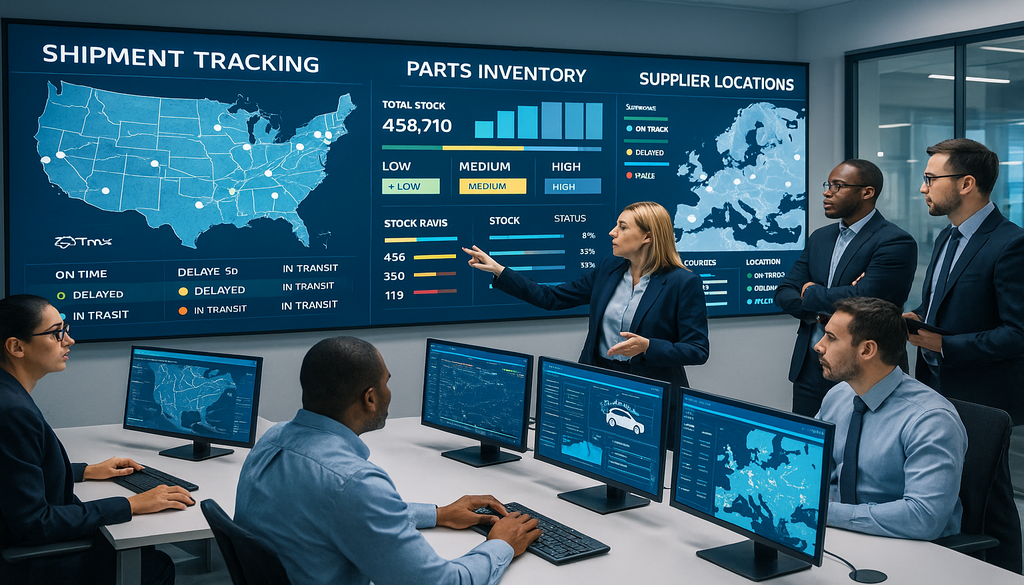Understanding the Impact of Logistics Software on the Auto Industry
In today's hyper-competitive automotive marketplace, efficiency isn't just desirable—it's essential for survival. Logistics software has emerged as a critical technological enabler for automotive manufacturers and suppliers seeking to optimize their operations in an increasingly complex global supply chain. This sophisticated technology encompasses specialized digital solutions designed to manage, track, and optimize the movement of parts, components, and finished vehicles throughout the automotive supply chain. For automotive companies facing pressure to reduce costs while improving delivery performance, logistics software provides the visibility and control necessary to achieve seemingly contradictory goals simultaneously.
The automotive industry presents unique logistical challenges that make specialized software solutions particularly valuable. With thousands of components sourced from global suppliers converging for just-in-time assembly, even minor disruptions can halt production lines costing thousands of dollars per minute. Logistics software brings order to this complexity by providing real-time visibility across the supply network. According to recent industry research, automotive manufacturers implementing comprehensive logistics software solutions have reported efficiency improvements of 15-30% in their supply chain operations, translating to millions in annual savings for larger operations. Beyond cost savings, these digital tools enable the flexibility and responsiveness essential for automotive companies navigating rapidly changing market conditions, regulatory requirements, and consumer preferences.
The strategic importance of logistics software in automotive operations continues to grow as manufacturers embrace digital transformation initiatives. With electric vehicle production accelerating and traditional supply chains evolving, logistics software serves as the central nervous system connecting disparate operations into a synchronized whole. For instance, major automakers like Toyota and Volkswagen have heavily invested in proprietary logistics platforms that coordinate their global operations, enabling them to respond more effectively to disruptions like the recent semiconductor shortage. These investments reflect a broader industry recognition that logistics excellence represents a significant competitive advantage in an industry where margins are tight and customer expectations continue to rise. As vehicles become more complex and customized, logistics software provides the foundation for managing this increasing complexity while maintaining operational efficiency.
Key Features of Logistics Software That Boost Auto Industry Operations
Real-time tracking and visibility capabilities represent perhaps the most transformative feature of modern logistics software in automotive operations. Unlike legacy systems that provided delayed or incomplete information, today's solutions offer instant visibility into the location and status of parts, components, and finished vehicles throughout the supply chain. This real-time awareness enables proactive decision-making when disruptions occur, allowing supply chain managers to reroute shipments, expedite critical components, or adjust production schedules to minimize impact. For automotive manufacturers operating with just-in-time inventory models, this visibility has proven invaluable in reducing both buffer inventory and production downtime. A recent study by McKinsey found that automotive companies with advanced tracking capabilities reduced emergency expediting costs by up to 35% while simultaneously improving on-time delivery performance—a dual benefit that directly impacts both operational costs and customer satisfaction.
Inventory management functionality specifically designed for automotive parts distribution represents another critical feature of specialized logistics software. The automotive industry deals with an extraordinary range of SKUs—from tiny fasteners to complete powertrain assemblies—each with different storage requirements, shelf lives, and demand patterns. Advanced logistics platforms provide sophisticated forecasting algorithms that analyze historical data, seasonal trends, and even external factors like economic indicators to optimize inventory levels across distribution networks. These systems can automatically adjust reorder points and safety stock levels based on changing demand patterns, reducing both excess inventory and stockouts. For automotive parts distributors, who typically manage inventories worth millions of dollars across multiple locations, these capabilities directly impact working capital requirements and service levels. Companies implementing such systems commonly report inventory reductions of 10-20% while simultaneously improving parts availability metrics—a combination that significantly enhances both profitability and customer satisfaction.
The ability to seamlessly integrate with existing enterprise systems represents a third crucial feature of effective automotive logistics software. Rather than functioning as isolated solutions, the most valuable logistics platforms connect directly with ERP systems, manufacturing execution systems, warehouse management systems, and transportation management platforms to create a unified digital ecosystem. This integration eliminates data silos and manual processes that introduce delays and errors into logistics operations. For example, when production schedules change in the manufacturing system, an integrated logistics platform can automatically adjust inbound material requirements, transportation bookings, and warehouse labor planning to accommodate the new timeline. Leading automotive suppliers have leveraged such integration to reduce order processing times by up to 65% while improving data accuracy across systems. This integrated approach enables a level of coordination and responsiveness that would be impossible with disconnected systems, allowing automotive companies to operate with greater agility despite their size and complexity.
Enhancing Supply Chain Management in Automotive Logistics
The digital backbone provided by comprehensive logistics software fundamentally transforms supply chain management in automotive operations by connecting previously siloed processes into a seamless, transparent flow. Traditional automotive supply chains often suffered from visibility gaps between tiers of suppliers, transportation providers, and manufacturing facilities, resulting in inefficient decision-making and reactive problem-solving. Modern logistics platforms eliminate these blind spots by providing end-to-end visibility and orchestration capabilities across the entire supply network. This comprehensive view enables proactive identification of potential disruptions before they impact production, allowing supply chain managers to implement mitigation strategies rather than crisis responses. According to research by Aberdeen Group, automotive companies with advanced supply chain visibility solutions respond to disruptions 3-5 times faster than those without such capabilities, significantly reducing the operational and financial impact of unexpected events. This accelerated response capability has proven particularly valuable during recent supply chain disruptions, allowing more digitally mature automotive companies to maintain production continuity while competitors faced extended shutdowns.
The implementation of advanced logistics software has yielded impressive results for companies willing to invest in digital transformation. Consider the case of a major European automotive manufacturer that implemented an integrated logistics platform connecting 450 suppliers across 23 countries. Within 18 months of deployment, the company reduced inventory carrying costs by 23% while simultaneously improving production line stoppage incidents by 35%—a combination that generated over €120 million in annual savings. Similarly, a North American Tier 1 supplier leveraged logistics software to optimize its distribution network, consolidating shipments and improving transportation utilization by 28%, resulting in significant cost savings and environmental benefits through reduced emissions. These success stories highlight the transformative potential of logistics software when implemented with clear strategic objectives and appropriate organizational change management. The most successful implementations typically involve cross-functional teams that include not only IT and logistics personnel but also representatives from manufacturing, purchasing, and finance to ensure alignment with broader business objectives.
Looking beyond operational improvements, logistics software enables automotive companies to transform their supply chains from cost centers into strategic assets that enhance competitiveness and customer satisfaction. By improving visibility and control over logistics operations, these platforms allow companies to offer more precise delivery commitments, respond more flexibly to changing customer requirements, and provide enhanced tracking information throughout the fulfillment process. These capabilities directly impact customer experience and loyalty, particularly in the aftermarket parts business where availability and delivery performance significantly influence purchase decisions. Furthermore, the data generated by logistics software provides invaluable insights into supply chain performance, cost drivers, and improvement opportunities that inform strategic decision-making. Leading automotive companies have established dedicated analytics teams that mine this data to identify network optimization opportunities, supplier performance trends, and emerging risks—turning operational data into strategic intelligence that guides long-term supply chain development and competitive positioning.
Precision Delivery and Efficient Shipping: A Dual Approach
Precision delivery represents a critical competitive differentiator in automotive logistics, particularly in aftermarket parts distribution and just-in-time manufacturing environments. Modern logistics software enables unprecedented delivery accuracy through sophisticated scheduling algorithms that account for production sequences, priority levels, transportation variables, and facility constraints. These systems optimize delivery windows down to specific dock doors and time slots, ensuring components arrive exactly when needed without creating congestion or excess inventory. For assembly operations, this precision directly impacts production efficiency by minimizing line-side inventory while eliminating costly shortages. In the aftermarket segment, precise delivery capabilities enhance customer satisfaction by providing reliable service levels and accurate delivery promises. A study by Automotive Logistics magazine found that parts distributors leveraging advanced logistics software improved on-time delivery performance by an average of 27% while simultaneously reducing expedited shipping costs. This improvement translates directly to customer retention and market share gains in the competitive automotive aftermarket, where service level often determines supplier selection more than price alone.
Efficient shipping optimization represents the complementary focus to precision delivery, ensuring automotive companies minimize transportation costs while meeting service requirements. Logistics software provides sophisticated capabilities to consolidate shipments, optimize routing, select appropriate carriers, and maximize vehicle utilization across complex distribution networks. These systems analyze thousands of possible combinations to identify the most efficient transportation plan given current orders, inventory positions, and service requirements. For automotive companies shipping thousands of parts daily across multiple channels, these optimization capabilities typically reduce transportation costs by 8-15% while improving service levels. Beyond direct cost savings, efficient shipping also reduces environmental impact through lower fuel consumption and emissions—an increasingly important consideration as automotive companies pursue sustainability initiatives. Leading logistics platforms now incorporate carbon calculation and reporting features that allow companies to measure, manage, and reduce the environmental footprint of their logistics operations while meeting regulatory requirements and corporate sustainability goals.
The integration of precision delivery and efficient shipping capabilities creates a powerful operational advantage for automotive companies navigating increasing market complexity. With the proliferation of vehicle models, customization options, and market channels, logistics complexity continues to grow exponentially. Logistics software enables companies to manage this complexity while maintaining or improving service levels through intelligent automation and decision support. For example, when a critical component shortage emerges, these systems can automatically evaluate alternative sourcing options, transportation modes, and production schedule impacts to recommend the optimal response strategy. This capability for rapid scenario analysis and optimization allows automotive companies to make informed decisions quickly in dynamic market conditions. Industry leaders have leveraged these capabilities to transform logistics from a reactive support function into a proactive strategic enabler that anticipates challenges and identifies opportunities before they become apparent to competitors, creating sustainable competitive advantage in both operational performance and customer satisfaction.
Challenges and Solutions in Implementing Logistics Software in the Auto Industry
Despite its transformative potential, implementing logistics software in automotive environments presents significant challenges that must be addressed for successful deployment. Legacy system integration often represents the most substantial technical hurdle, as established automotive companies typically operate with a complex landscape of existing applications developed over decades. These systems frequently contain critical operational data but may use outdated technologies or proprietary interfaces that complicate integration with modern logistics platforms. Successful implementations typically adopt a phased approach, creating middleware connectors or API layers that enable systems to communicate without requiring complete replacement of legacy applications. Another common challenge involves data quality and standardization issues that emerge when consolidating information from disparate sources. Automotive supply chains generate enormous volumes of data across multiple tiers of suppliers, transportation providers, and manufacturing facilities, often using inconsistent formats and definitions. Comprehensive data cleansing, mapping, and governance processes must precede implementation to ensure the new system operates with accurate, consistent information. Companies that invest adequately in these preparatory steps typically achieve faster implementation timelines and higher initial adoption rates than those that rush deployment without addressing fundamental data issues.
Organizational resistance and change management challenges frequently pose greater obstacles than technical issues during logistics software implementation. Automotive companies often have established processes and organizational structures built around existing systems, creating resistance when new software requires different workflows or responsibilities. Frontline employees may fear job displacement or struggle to adapt to new technologies, while middle managers may resist changes that alter their scope of control or performance metrics. Addressing these concerns requires comprehensive change management programs that include early stakeholder engagement, transparent communication about implementation objectives, robust training programs, and visible executive sponsorship. Leading companies establish cross-functional implementation teams with representatives from all affected departments to ensure diverse perspectives inform the deployment approach. These teams typically include "super users" who receive advanced training and serve as internal champions and resources during the transition period. Companies that invest adequately in change management report implementation timelines 40% shorter and user adoption rates 35% higher than those focusing primarily on technical aspects of deployment.
Strategic solutions for effective implementation begin with clearly defined business objectives that guide software selection and deployment priorities. Rather than viewing logistics software as a generic IT upgrade, successful companies identify specific operational challenges and improvement opportunities the software should address. This business-driven approach ensures technology investments align with strategic priorities and deliver measurable value. Phased implementation represents another best practice, beginning with high-value, lower-complexity modules that demonstrate quick wins and build organizational momentum before tackling more challenging areas. For example, many automotive companies start with transportation management functionality before expanding to more complex warehouse or inventory optimization capabilities. This incremental approach reduces implementation risk while allowing the organization to develop experience and confidence with the new platform. Finally, establishing robust governance and continuous improvement processes ensures the software evolves with changing business requirements after initial deployment. Leading companies establish dedicated teams responsible for monitoring system performance, identifying enhancement opportunities, and prioritizing ongoing development to maintain alignment with business objectives. This sustained focus ensures logistics software delivers long-term value rather than deteriorating into a legacy constraint as business requirements evolve.
Conclusion
The transformative impact of logistics software on automotive operations cannot be overstated in today's complex manufacturing environment. As we've explored throughout this article, these sophisticated digital solutions provide the visibility, control, and optimization capabilities essential for maintaining competitiveness in a rapidly evolving industry. From enhancing supply chain management to enabling precision delivery and efficient shipping, logistics software serves as the digital foundation upon which modern automotive logistics operations are built. The most successful implementations demonstrate that when properly deployed with clear business objectives and appropriate change management, these systems deliver substantial returns through reduced costs, improved service levels, and enhanced operational flexibility.
For automotive executives considering investments in logistics technology, the path forward requires careful strategic planning and organizational alignment rather than simply purchasing software. The case studies and implementation approaches discussed highlight the importance of treating logistics software as a business transformation initiative rather than merely an IT project. As vehicle technology continues to evolve toward electrification, connectivity, and autonomy, the underlying logistics capabilities enabled by sophisticated software will become even more critical to competitive success. Companies that establish strong digital foundations today will be better positioned to navigate future supply chain challenges and capitalize on emerging opportunities in the automotive marketplace.
Frequently Asked Questions (FAQ)
Q1: What are the primary benefits of using logistics software in the auto industry?
A1: The primary benefits include enhanced supply chain visibility, improved inventory management, and increased efficiency in shipping and delivery processes. Automotive companies implementing comprehensive logistics solutions typically report 15-30% efficiency improvements, 10-20% inventory reductions, and 8-15% transportation cost savings. Additional benefits include faster response to disruptions, improved production continuity, enhanced customer service through more accurate delivery promises, and better strategic decision-making through data-driven insights. These improvements directly impact both operational costs and revenue generation through improved customer satisfaction and retention.
Q2: How does logistics software contribute to precision delivery in automotive logistics?
A2: It utilizes advanced tracking and scheduling features to ensure accurate and timely delivery of car parts, crucial for maintaining production schedules and reducing downtime. Sophisticated algorithms optimize delivery windows to specific dock doors and time slots, accounting for production sequences, priority levels, transportation variables, and facility constraints. Real-time visibility allows for proactive adjustment when disruptions occur, while automated notifications keep stakeholders informed throughout the delivery process. For assembly operations, this precision minimizes line-side inventory while preventing costly shortages. In aftermarket distribution, it enhances customer satisfaction through reliable service levels and accurate delivery promises.
Q3: Can logistics software integrate with other systems used in the auto industry?
A3: Yes, most modern logistics software solutions are designed to seamlessly integrate with existing ERP systems and other digital tools used in the auto industry for a unified operational approach. Integration capabilities typically include API connections, EDI functionality, middleware options, and pre-built connectors for common automotive systems. This integration eliminates data silos and manual processes that introduce delays and errors. When production schedules change in manufacturing systems, integrated logistics platforms automatically adjust material requirements, transportation bookings, and warehouse planning to accommodate new timelines. Leading automotive suppliers have leveraged such integration to reduce order processing times by up to 65% while improving data accuracy across systems.
Q4: What are some challenges companies might face when implementing logistics software?
A4: Challenges can include data migration issues, training staff to use new software, and initial integration hiccups with existing systems. Legacy system integration often presents significant technical hurdles, particularly in established automotive companies with complex application landscapes developed over decades. Data quality and standardization issues frequently emerge when consolidating information from disparate sources using inconsistent formats and definitions. Organizational resistance and change management challenges may pose greater obstacles than technical issues, as existing processes and responsibilities must evolve to leverage new capabilities. Inadequate executive sponsorship, unclear business objectives, or attempting too much change simultaneously can further complicate implementation efforts and reduce adoption rates.
Q5: Are there specific features to look for when choosing logistics software for the auto industry?
A5: Key features to consider include robust inventory management, real-time tracking capabilities, integration options, and support for precision delivery and efficient shipping processes. Automotive-specific functionality should include support for sequenced delivery, kitting operations, returnable container management, and complex part numbering systems common in the industry. Advanced analytics capabilities provide valuable insights into performance trends and improvement opportunities, while scenario planning tools enable quick evaluation of alternative strategies during disruptions. User interface considerations are important for ensuring adoption, particularly for mobile users like drivers and warehouse personnel. Finally, the vendor's industry expertise, implementation methodology, and ongoing support capabilities should align with your organization's needs and internal resources to ensure long-term success.







